QT/ Snapshots of photoinjection
June 13th 2023
Quantum news biweekly vol.53, 30th May — 13th June
TL;DR
- Ultrafast laser physicists from the attoworld team have gained new insights into the dynamics of electrons in solids immediately after photoinjection.
- Scientists have developed a nanodevice that can measure the absolute power of microwave radiation down to the femtowatt level at ultra-low temperatures — a scale trillion times lower than routinely used in verifiable power measurements. The device has the potential to significantly advance microwave measurements in quantum technology.
- Scientists have found a new way to create a crystalline structure called a ‘density wave’ in an atomic gas. The findings can help us better understand the behavior of quantum matter, one of the most complex problems in physics.
- Researchers have developed an algorithm that more precisely predicts a beam’s distribution of particle positions and velocities as it zips through an accelerator.
- In the future, communications networks and computers will use information stored in objects governed by the microscopic laws of quantum mechanics. This capability can potentially underpin communication with greatly enhanced security and computers with unprecedented power. A vital component of these technologies will be memory devices capable of storing quantum information to be retrieved at will.
- An international research team has now succeeded in discovering a formation and decay process of the solvated dielectron.
- Researchers from the RIKEN Center for Emergent Matter Science and collaborators have succeeded in creating a “superlattice” of semiconductor quantum dots that can behave like a metal, potentially imparting exciting new properties to this popular class of materials.
- New experiments using one-dimensional gases of ultra-cold atoms reveal a universality in how quantum systems composed of many particles change over time following a large influx of energy that throws the system out of equilibrium.
- The connection between quantum physics and the theory of relativity is extremely hard to study. But now, scientists have set up a model system, which can help: Quantum particles can be tuned in such a way that the results can be translated into information about other systems, which are much harder to observe. This kind of ‘quantum simulator’ works very well and can lead to new insights about the nature of relativity and quantum physics.
- Researchers have identified novel van der Waals (vdW) magnets using cutting-edge tools in artificial intelligence (AI). In particular, the team identified transition metal halide vdW materials with large magnetic moments that are predicted to be chemically stable using semi-supervised learning. These two-dimensional (2D) vdW magnets have potential applications in data storage, spintronics, and even quantum computing.
- And more!
Quantum Computing Market
According to the recent market research report ‘Quantum Computing Market with COVID-19 impact by Offering (Systems and Services), Deployment (On Premises and Cloud Based), Application, Technology, End-use Industry and Region — Global Forecast to 2026’, published by MarketsandMarkets, the Quantum Computing market is expected to grow from USD 472 million in 2021 to USD 1,765 million by 2026, at a CAGR of 30.2%. The early adoption of quantum computing in the banking and finance sector is expected to fuel the growth of the market globally. Other key factors contributing to the growth of the quantum computing market include rising investments by governments of different countries to carry out research and development activities related to quantum computing technology. Several companies are focusing on the adoption of QCaaS post-COVID-19. This, in turn, is expected to contribute to the growth of the quantum computing market. However, stability and error correction issues are expected to restrain the growth of the market.
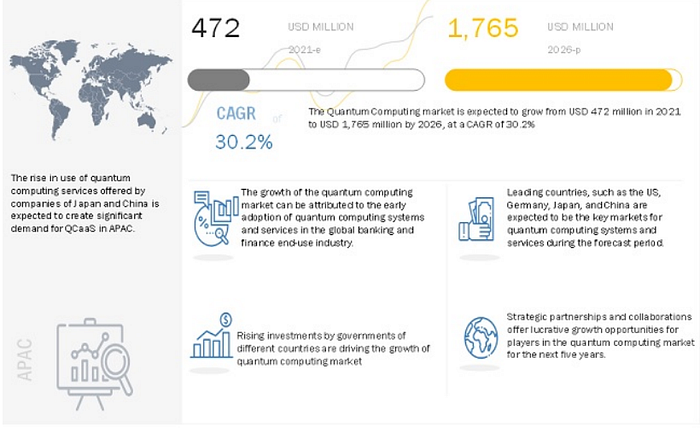
According to ‘Quantum Computing Market Research Report: By Offering, Deployment Type, Application, Technology, Industry — Industry Share, Growth, Drivers, Trends and Demand Forecast to 2030’ report, the quantum computing market is projected to reach $64,988 million by 2030. Machine learning (ML) is expected to progress at the highest CAGR, during the forecast period, among all application categories, owing to the fact that quantum computing is being integrated in ML for improving the latter’s use case.
Latest Research
Dynamic optical response of solids following 1-fs-scale photoinjection
by Dmitry A. Zimin, Nicholas Karpowicz, Muhammad Qasim, Matthew Weidman, Ferenc Krausz, Vladislav S. Yakovlev in Nature
Ultrafast laser physicists from the attoworld team at LMU and the Max Planck Institute of Quantum Optics have gained new insights into the dynamics of electrons in solids immediately after photoinjection.
A laser pulse hits an electron in a solid. If it receives enough energy from the light wave, it can then move freely through a solid. This phenomenon, which scientists have been exploring since the beginning of quantum mechanics, is called photoinjection. There are still open questions about how the relevant processes unfold in time. Laser physicists of the attoworld team of LMU and the Max Planck Institute of Quantum Optics have now made a direct observation of how the optical properties of silicon and silicon dioxide evolve during the first few femtoseconds (millionths of a billionth of a second) after photoinjection with a strong laser pulse.
This physics of photoinjection is relatively simple when it comes to the photoelectric effect explained by Albert Einstein. Here, an electron absorbs a single photon that has enough energy to free the electron from a potential that constrains its motion. It gets more complicated when no photon in the light wave has enough energy to do so. In this case, bound electrons can become free by absorbing more than one photon at once or by quantum tunneling. These are nonlinear processes that are effective only when the electric field is strong, which means that only the central part of a laser pulse can drive them efficiently.

Field-resolved detection of charge-carrier motion controlled by sub-half-cycle photoinjection.
With the tools of attosecond science, it is possible to produce most charge carriers within a single half-cycle of a light pulse, increasing the conductivity of a solid by orders of magnitude within just a few femtoseconds. The laser physicists of the attoworld team at LMU and the Max Planck Institute of Quantum Optics have investigated how quickly solids change their optical properties after ultrafast photoinjection. To do so, they sent two few-cycle pulses through a thin sample: an intense pump pulse that created charge carriers and a weak test pulse that interacted with them.
Because photoinjection was confined to a time interval shorter than half a cycle of the test field, it was possible to observe how charge carriers interacted with the test field during the first femtoseconds after their appearance. This information was encoded in the distortions that photoinjection imprinted on the time-dependent electric field of the test pulse. The scientists measured these distortions using a novel technique for optical-field sampling, and they repeated their measurements for many delays between the two pulses.
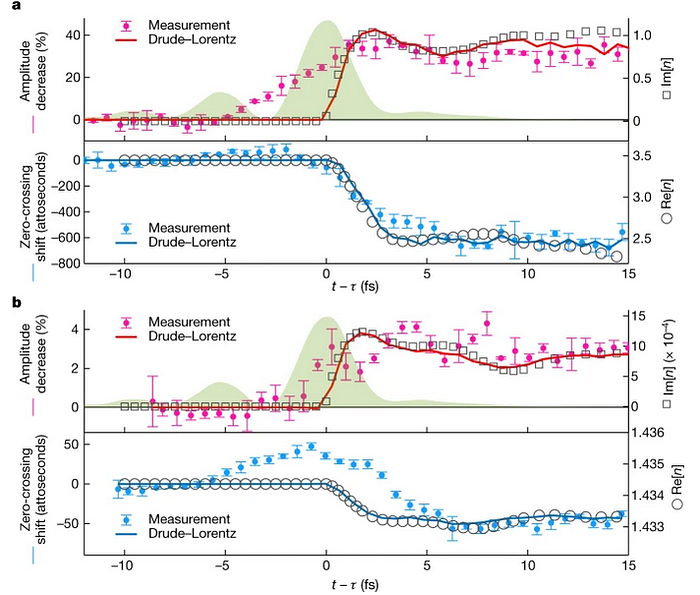
Time dependence of optical properties.
The innovative technique for optical-field-resolved pump-probe measurements now gives the attoworld team direct access to light-driven electric currents during and after photoinjection.
“The most important result is that we now know how to perform and analyze such experiments and that we indeed saw the light-driven electron motion as no one could do before,” says Vladislav Yakovlev, last author of the study. “We were surprised to see no clear signs of quasiparticle formation,” Yakovlev explains further. “This means that, in these particular measurements, the many-body physics measurements did not have much influence on how the conductivity of the medium built up after photoinjection, but we may see some fancier physics in the future.”
All modern electronics are based on controlling the flow of charge carriers by rapidly increasing and decreasing their ability to move through circuits. The attoworld team’s research is about reaching the ultimate speed limits of this control using light. The new findings could eventually help achieve future signal processing in the petahertz range, making so-called lightwave electronics possible. That would speed up today’s electronics by about 100,000 times.
“I would argue that we’ve just scratched the surface of what pump-probe field-resolved measurements can do. Equipped with our experience and insights, other researchers can now use our approach to answer their questions,” Yakovlev is convinced.
Cryogenic sensor enabling broad-band and traceable power measurements
by J.-P. Girard, R. E. Lake, W. Liu, R. Kokkoniemi, E. Visakorpi, J. Govenius, M. Möttönen in Review of Scientific Instruments
Scientists in Finland have developed a nanodevice that can measure the absolute power of microwave radiation down to the femtowatt level at ultra-low temperatures — a scale trillion times lower than routinely used in verifiable power measurements. The device has the potential to significantly advance microwave measurements in quantum technology.
Quantum science takes place mostly at ultra-low temperatures using devices called dilution refrigerators. The experiments also have to be done at tiny energy levels — down to the energy level of single photons or even less. Researchers have to measure these extremely low energy levels as accurately as possible, which means also accounting for heat — a persistent problem for quantum devices. To measure heat in quantum experiments, scientists use a special type of thermometer called a bolometer. An exceptionally accurate bolometer was recently developed at Aalto by a team led by Mikko Möttönen, associate professor of quantum technology at Aalto and VTT, but the device had more uncertainty than they had hoped for. Although it enabled them to observe the relative power level, they couldn’t determine the absolute amount of energy very accurately.
In the new study, Möttönen’s team worked with researchers at the quantum-technology companies Bluefors and IQM, and VTT Technical Research Centre of Finland to improve the bolometer.
‘We added a heater to the bolometer, so we can apply a known heater current and measure the voltage. Since we know the precise amount of power we’re putting into the heater, we can calibrate the power of the input radiation against the heater power. The result is a self-calibrating bolometer working at low temperatures, which allows us to accurately measure absolute powers at cryogenic temperatures,’ Möttönen says.
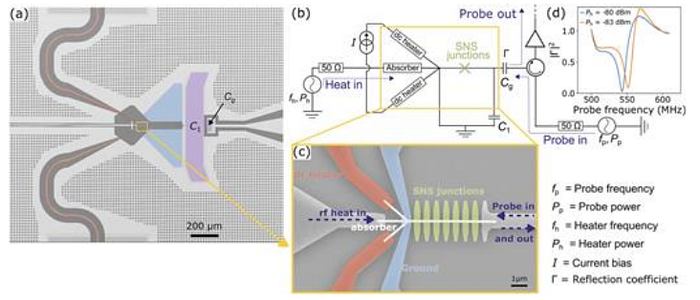
Description of the bolometer sample.
According to Russell Lake, director of quantum applications at Bluefors, the new bolometer is a significant step forward in measuring microwave power.
‘Commercial power sensors typically measure power at the scale of one milliwatt. This bolometer does that accurately and reliably at one femtowatt or below. That’s a trillion times less power than used in typical power calibrations.’
Möttönen explains that the new bolometer could improve the performance of quantum computers. ‘For accurate results, the measurement lines used to control qubits should be at very low temperatures, void of any thermal photons and excess radiation. Now with this bolometer, we can actually measure that radiation temperature without interference from the qubit circuitry,’ he says. The bolometer also covers a very broad range of frequencies.
‘The sensor is broadband, which means that it can measure what is the power absorbed in various frequencies. This is not a given in quantum technology as usually the sensors are limited to a very narrow band,’ says Jean-Philippe Girard, a scientist at Bluefors who also previously worked at Aalto on the device.
The team says the bolometer provides a major boost to quantum technology fields.
‘Measuring microwaves happens in wireless communications, radar technology, and many other fields. They have their ways of performing accurate measurements, but there was no way to do the same when measuring very weak microwave signals for quantum technology. The bolometer is an advanced diagnostic instrument that has been missing from the quantum technology toolbox until now,’ Lake says.
The work is a result of seamless collaboration between Aalto University and Bluefors, a perfect example of academy and industry complementing each other’s strengths. The device was developed at Aalto’s Quantum Computing and Devices (QCD) group, which is part of the Academy of Finland Centre of Excellence in Quantum Technology (QTF). They used Micronova cleanrooms that belong to the national research infrastructure OtaNano. Since the first experiments at Aalto, Bluefors has also successfully tested these devices in their own industrial facilities.
‘That shows that this is not just a lucky break in a university lab, but something that both the industrial and the academic professionals working in quantum technology can benefit from,’ Möttönen says.
Density-wave ordering in a unitary Fermi gas with photon-mediated interactions
by Victor Helson, Timo Zwettler, Farokh Mivehvar, Elvia Colella, Kevin Roux, Hideki Konishi, Helmut Ritsch, Jean-Philippe Brantut in Nature
Scientists at EPFL have found a new way to create a crystalline structure called a “density wave” in an atomic gas. The findings can help us better understand the behavior of quantum matter, one of the most complex problems in physics.
“Cold atomic gases were well known in the past for the ability to ‘program’ the interactions between atoms,” says Professor Jean-Philippe Brantut at EPFL. “Our experiment doubles this ability!” Working with the group of Professor Helmut Ritsch at the University of Innsbruck, they have made a breakthrough that can impact not only quantum research but quantum-based technologies in the future.
Scientists have long been interested in understanding how materials self-organize into complex structures, such as crystals. In the often-arcane world of quantum physics, this sort of self-organization of particles is seen in ‘density waves’, where particles arrange themselves into a regular, repeating pattern or ‘order’; like a group of people with different colored shirts on standing in a line but in a pattern where no two people with the same color shirt stand next to each other.
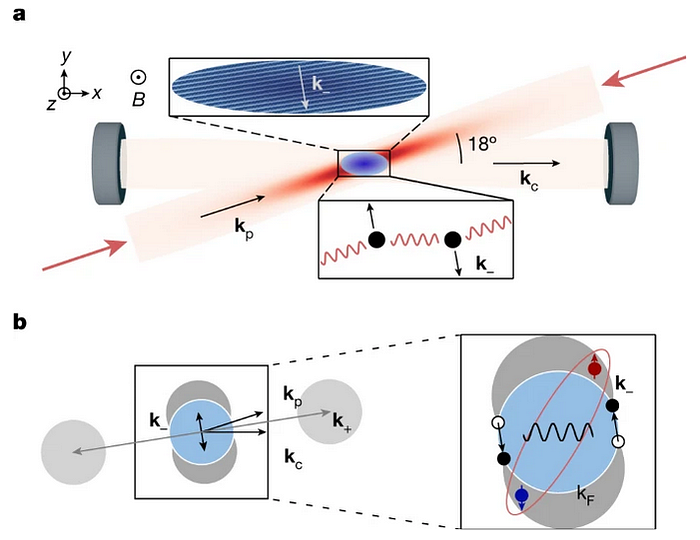
Concept of the experiment.
Density waves are observed in a variety of materials, including metals, insulators, and superconductors. However, studying them has been difficult, especially when this order (the patterns of particles in the wave) occurs with other types of organization such as superfluidity — a property that allows particles to flow without resistance. It’s worth noting that superfluidity is not just a theoretical curiosity; it is of immense interest for developing materials with unique properties, such as high-temperature superconductivity, which could lead to more efficient energy transfer and storage, or for building quantum computers.
To explore this interplay, Brantut and his colleagues, the researchers created a “unitary Fermi gas,” a thin gas of lithium atoms cooled to extremely low temperatures, and where atoms collide with each other very often. The researchers then placed this gas in an optical cavity, a device used to confine light in a small space for an extended period of time. Optical cavities are made of two facing mirrors that reflect incoming light back and forth between them thousands of times, allowing light particles, photons, to build up inside the cavity.
In the study, the researchers used the cavity to cause the particles in the Fermi gas to interact at long distance: a first atom would emit a photon that bounces onto the mirrors, which is then reabsorbed by second atom of the gas, regardless how far it is from the first. When enough photons are emitted and reabsorbed — easily tuned in the experiment — the atoms collectively organize into a density wave pattern.
“The combination of atoms colliding directly with each other in the Fermi gas, while simultaneously exchanging photons over long distance, is a new type of matter where the interactions are extreme,” says Brantut. “We hope what we will see there will improve our understanding of some of the most complex materials encountered in physics.”
Phase Space Reconstruction from Accelerator Beam Measurements Using Neural Networks and Differentiable Simulations
by R. Roussel, A. Edelen, C. Mayes, D. Ratner, J. P. Gonzalez-Aguilera, S. Kim, E. Wisniewski, J. Power in Physical Review Letters
Whenever SLAC National Accelerator Laboratory’s linear accelerator is on, packs of around a billion electrons each travel together at nearly the speed of light through metal piping. These electron bunches form the accelerator’s particle beam, which is used to study the atomic behavior of molecules, novel materials and many other subjects. But trying to estimate what a particle beam actually looks like as it travels through an accelerator is difficult, leaving scientists often with only a rough approximation of how a beam will behave during an experiment.
Now, researchers at the Department of Energy’s SLAC, the DOE’s Argonne National Laboratory and the University of Chicago have developed an algorithm that more precisely predicts a beam’s distribution of particle positions and velocities as it zips through an accelerator. This detailed beam information will help scientists perform their experiments more reliably — a need that is becoming increasingly important as accelerator facilities operate at higher and higher energies and generate more complex beam profiles.
“We have a lot of different ways to manipulate particle beams inside of accelerators, but we don’t have a really precise way to describe a beam’s shape and momentum,” SLAC accelerator scientist and lead co-author Ryan Roussel said. “Our algorithm takes into account information about a beam that is normally discarded and uses that information to paint a more detailed picture of the beam.”
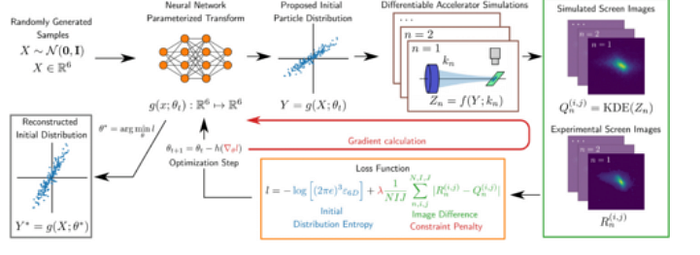
Description of the approach for reconstructing phase space beam distributions.
Typically, researchers describe the positions and speeds of particles in a beam in terms of a few summary statistics that provide a rough shape of the beam overall — but that approach throws out a lot of potentially useful information. Alternatively, beam scientists can take many measurements of the beam itself and try to reconstruct, sometimes using machine learning, what the beam would look like under different experimental circumstances — but those methods require a lot of data and a lot of computational power.
For this study, the team tried a new approach: They built a machine learning model that uses our understanding of beam dynamics to predict the distribution of particles positions and speeds within the beam, collectively known as the beam’s phase space distribution. To test their ideas, the team used their model to interpret experimental data from the Argonne Wakefield Accelerator at the DOE’s Argonne National Laboratory. Including the physics of particle beam dynamics with the experimental data allowed the researchers to accurately reconstruct fine details of the beam using only 10 data points — a task that might take up to 10,000 data points for some machine learning models that don’t include a model of beam physics.
“Most machine learning models don’t directly include any notion of particle beam dynamics to speed up learning and reduce the amount of data required,” SLAC accelerator scientist and co-author Auralee Edelen said. “We’ve shown that we can infer very complicated high-dimensional beam shapes from astonishingly small amounts of data.”
The algorithm can currently reconstruct a model of a beam along its up-down and left-right axes, as if the particle bunch were a pancake moving down the accelerator path. This type of reconstruction is called 4D beam phase space. Next, researchers want to demonstrate the algorithm experimentally on reconstructing full 6D phase space distributions, which includes particle positions and speed along the direction in which the beam is traveling. Overall, the algorithm is a major paradigm shift in the way we analyze experimental accelerator data at facilities today, Roussel said.
“We can now use particle beam data in a more comprehensive, powerful way to improve our scientific goals at accelerators everywhere,” he said.
Variance-based sensitivity analysis of Λ-type quantum memory
by Kai Shinbrough, Virginia O. Lorenz in Physical Review A
In the future, communications networks and computers will use information stored in objects governed by the microscopic laws of quantum mechanics. This capability can potentially underpin communication with greatly enhanced security and computers with unprecedented power. A vital component of these technologies will be memory devices capable of storing quantum information to be retrieved at will.
Virginia Lorenz, a professor of physics at the University of Illinois Urbana-Champaign, studies Lambda-type optical quantum memory devices, a promising technology that relies on light interacting with a large group of atoms. She is developing a device based on hot metallic vapor with graduate student Kai Shinbrough. As the researchers work towards a practical device, they are also providing some of the first theoretical analyses of Lambda-type devices.
“Prior to this paper, you would just have to assume that everything in the quantum memory behaves ideally,” Shinbrough said. “This is the first time that things like noise have been considered, and the results of our analyses inform experimental design.”
Lambda-type quantum memory uses a collection of atoms that interacts with two kinds of light: single photons containing quantum information that are absorbed, and powerful laser pulses controlling when the photons’ information is absorbed and released. There are several storage-and-retrieval protocols that rely on different mechanisms, and the best choice is determined by the properties of the atoms and the controlling laser pulses.
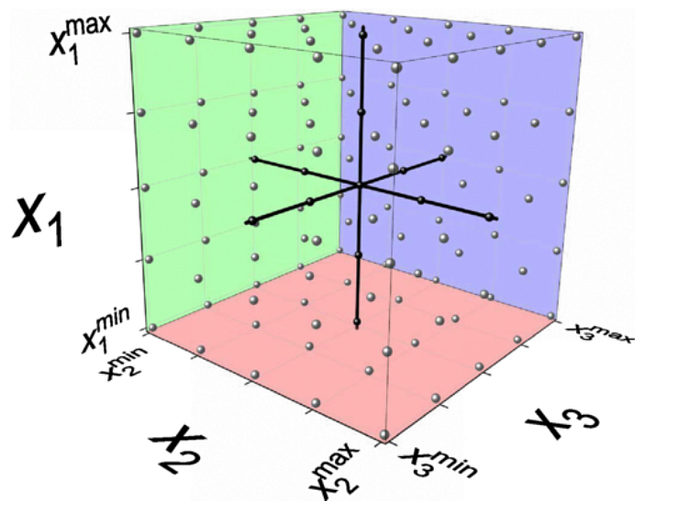
Example of three-dimensional phase space spanned by parameters X=(x1,x2,x3); the sample points connected by the black lines correspond to one-at-a-time (OAT) analysis of the system sensitivity, which explores only a small fraction of the total phase space.
Past analyses of these protocols assumed ideal conditions. Effects like device noise and small errors in experimental settings were not discussed. Shinbrough and Lorenz needed to understand these effects to develop a robust quantum memory device, so they filled this gap in the literature. They analyzed the impact of both random device noise and slow overall drift in experimental parameters on a Lambda-type device’s memory efficiency, a measure of how often the device works as intended.
“The techniques we used are well established in classical physics and engineering, but we’re applying them to a quantum system for the first time,” Shinbrough said.
In addition to considering how noise and drift in experimental parameters individually impact device performance, the researchers used the technique of Sobol’ sensitivity analysis to study how the simultaneous variation of all parameters impacts the memory efficiency. This allowed them to identify the parameters that had the most significant impact for each protocol and determine how variations in different parameters combine.
Shinbrough explained that the central result of this analysis is understanding how different experimental parameters may be tuned to compensate for imperfections in different settings. He gave the example of variation in the arrival times of the control pulse and the single photon. Each memory mechanism relies on a carefully tuned delay in the arrival times. If this delay begins to drift, then the control pulse can be made to last longer in time so the overlap with the single photon is roughly the same and the impact on memory efficiency is mitigated.
The results of this analysis have informed Shinbrough and Lorenz’s experimental efforts. The researchers found that certain effects like variations in the hot metal vapor are often negligible while others like the characteristics of the controlling pulse can have a significant impact on experimental performance.
“Our analyses have allowed us to develop a better-informed experiment taking full advantage of our device’s properties,” Lorenz said. “Moreover, we have developed a framework that allows others to perform the same analyses for their experiments.”
Solvated dielectrons from optical excitation: An effective source of low-energy electrons
by Sebastian Hartweg et al in Science
Solvated dielectrons are the subject of many hypotheses among scientists, but have never been directly observed. They are described as a pair of electrons that is dissolved in liquids such as water or liquid ammonia. To make space for the electrons a cavity forms in the liquid that the two electrons occupy.
An international research team led by Dr. Sebastian Hartweg, initially at Synchrotron SOLEIL (France), now at the Institute of Physics at the University of Freiburg and Prof. Dr. Ruth Signorell from ETH Zurich, including scientists from the synchrotron SOLEIL and Auburn University has now succeeded in discovering a formation and decay process of the solvated dielectron.
In experiments at the synchrotron SOLEIL (DESIRS beamline), the consortium found direct evidence supported by quantum chemical calculations for the formation of these electron pairs by excitation with ultraviolet light in tiny ammonia droplets containing a single sodium atom.
When dielectrons are formed by excitation with ultraviolet light in tiny ammonia droplets containing a sodium atom, they leave traces in an unusual process that scientists have now been able to observe for the first time. In this process, one of the two electrons migrates to the neighboring solvent molecules, while at the same time the other electron is ejected. “The surprising thing about this is that similar processes have previously been observed mainly at much higher excitation energies,” says Hartweg.
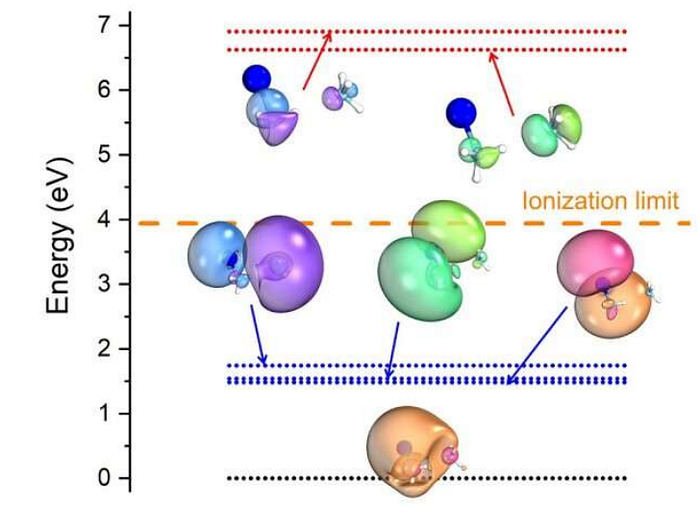
Excitation energies and associated orbitals for Na(NH3)1(NH3)1.
The team focused on this second electron because there could be interesting applications for it. On the one hand, the ejected electron is produced with very low kinetic energy, so it moves very slowly. On the other hand, this energy can be controlled by the irradiated UV light, which starts the whole process. Solvated dielectrons could thus serve as a good source of low-energy electrons.
Such slow electrons can set a wide variety of chemical processes in motion. For example, they play a role in the cascade of processes that lead to radiation damage in biological tissue. They are also important in synthetic chemistry, where they serve as effective reducing agents. By being able to selectively generate slow electrons with variable energy, the mechanisms of such chemical processes can be studied in more detail in the future. In addition, the energy made available to the electrons in a controlled manner might also be used to increase the effectiveness of reduction reactions.
“These are interesting prospects for possible applications in the future,” says Hartweg. “Our work provides the basis for this and helps to understand these exotic and still enigmatic solvated dielectrons a little better.”
Enabling Metallic Behaviour in Two-Dimensional Superlattice of Semiconductor Colloidal Quantum Dots
by Satria Zulkarnaen Bisri et al in Nature Communications
Researchers from the RIKEN Center for Emergent Matter Science and collaborators have succeeded in creating a “superlattice” of semiconductor quantum dots that can behave like a metal, potentially imparting exciting new properties to this popular class of materials.
Semiconducting colloidal quantum dots have garnered tremendous research interest due to their special optical properties, which arise from the quantum confinement effect. They are used in solar cells, where they can improve the efficiency of energy conversion, biological imaging, where they can be used as fluorescent probes, electronic displays, and even quantum computing, where their ability to trap and manipulate individual electrons can be exploited.
However, getting semiconductor quantum dots to efficiently conduct electricity has been a major challenge, impeding their full use. This is primarily due to their lack of orientational order in assemblies. According to Satria Zulkarnaen Bisri, lead researcher on the project, “making them metallic would enable, for example, quantum dot displays that are brighter yet use less energy than current devices.”

Epitaxially-connected PbS quantum dot superlattices (QD-SL).
Now, the group has published a study that could make a major contribution to reaching that goal. The group, led by Bisri and Yoshihiro Iwasa of RIKEN CEMS, has created a superlattice of lead sulfide semiconducting colloidal quantum dots that displays the electrical conducting properties of a metal. The key to achieving this was to get the individual quantum dots in the lattice to attach to one another directly, “epitaxially,” without ligands, and to do this with their facets oriented in a precise way.
The researchers tested the conductivity of the material they created, and as they increased the carrier density using a electric, double-layer transistor, they found that at a certain point it became a million times more conductive than what is currently available from quantum dot displays. Importantly, the quantum confinement of the individual quantum dots was still maintained, meaning that they don’t lose their functionality despite the high conductivity.
“Semiconductor quantum dots have always shown promise for their optical properties, but their electronic mobility has been a challenge,” says Iwasa. “Our research has demonstrated that precise orientation control of the quantum dots in the assembly can lead to high electronic mobility and metallic behavior. This breakthrough could open up new avenues for using semiconductor quantum dots in emerging technologies.”
According to Bisri, “We plan to carry out further studies with this class of materials, and believe it could lead to vast improvements in the capabilities of quantum dot superlattices. In addition to improving current devices, it could lead to new applications such as true all-QD direct electroluminescence devices, electrically driven lasers, thermoelectric devices, and highly sensitive detectors and sensors, which previously were beyond the scope of quantum dot materials.”
Observation of hydrodynamization and local prethermalization in 1D Bose gases
by Yuan Le, Yicheng Zhang, Sarang Gopalakrishnan, Marcos Rigol, David S. Weiss in Nature
New experiments using one-dimensional gases of ultra-cold atoms reveal a universality in how quantum systems composed of many particles change over time following a large influx of energy that throws the system out of equilibrium. A team of physicists at Penn State showed that these gases immediately respond, “evolving” with features that are common to all “many-body” quantum systems thrown out of equilibrium in this way.
“Many major advances in physics over the last century have concerned the behavior of quantum systems with many particles,” said David Weiss, Distinguished Professor of Physics at Penn State and one of the leaders of the research team. “Despite the staggering array of diverse ‘many-body’ phenomena, like superconductivity, superfluidity, and magnetism, it was found that their behavior near equilibrium is often similar enough that they can be sorted into a small set of universal classes. In contrast, the behavior of systems that are far from equilibrium has yielded to few such unifying descriptions.”
These quantum many-body systems are ensembles of particles, like atoms, that are free to move around relative to each other, Weiss explained. When they are some combination of dense and cold enough, which can vary depending on the context, quantum mechanics — the fundamental theory that describes the properties of nature at the atomic or subatomic scale — is required to describe their dynamics.
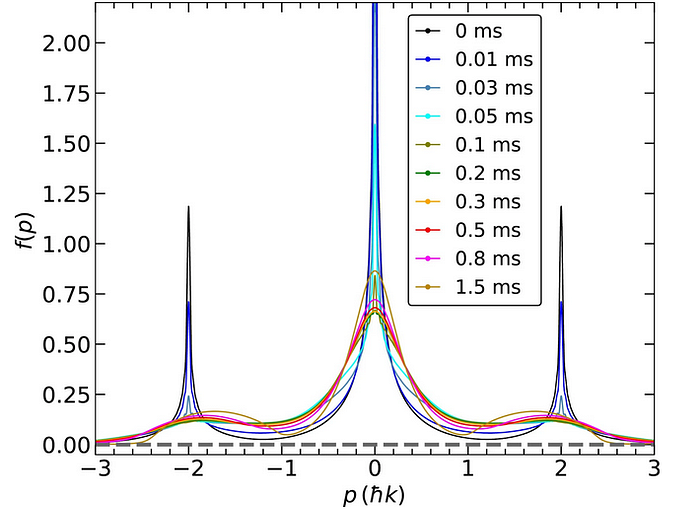
Theoretical momentum distributions.
Dramatically out-of-equilibrium systems are routinely created in particle accelerators when pairs of heavy ions are collided at speeds near the speed-of-light. The collisions produce a plasma — composed of the subatomic particles “quarks” and “gluons” — that emerges very early in the collision and can be described by a hydrodynamic theory — similar to the classical theory used to describe air flow or other moving fluids — well before the plasma reaches local thermal equilibrium. But what happens in the astonishingly short time before hydrodynamic theory can be used?
“The physical process that occurs before hydrodynamics can be used has been called ‘hydrodynamization,” said Marcos Rigol, professor of physics at Penn State and another leader of the research team. “Many theories have been developed to try to understand hydrodynamization in these collisions, but the situation is quite complicated and it is not possible to actually observe it as it happens in the particle accelerator experiments. Using cold atoms, we can observe what is happening during hydrodynamization.”
The Penn State researchers took advantage of two special features of one-dimensional gases, which are trapped and cooled to near absolute zero by lasers, in order to understand the evolution of the system after it is thrown of out of equilibrium, but before hydrodynamics can be applied. The first feature is experimental. Interactions in the experiment can be suddenly turned off at any point following the influx of energy, so the evolution of the system can be directly observed and measured. Specifically, they observed the time-evolution of one-dimensional momentum distributions after the sudden quench in energy.
“Ultra-cold atoms in traps made from lasers allow for such exquisite control and measurement that they can really shed light on many-body physics,” said Weiss. “It is amazing that the same basic physics that characterize relativistic heavy ion collisions, some of the most energetic collisions ever made in a lab, also show up in the much less energetic collisions we make in our lab.”
The second feature is theoretical. A collection of particles that interact with each other in a complicated way can be described as a collection of “quasiparticles” whose mutual interactions are much simpler. Unlike in most systems, the quasiparticle description of one-dimensional gases is mathematically exact. It allows for a very clear description of why energy is rapidly redistributed across the system after it is thrown out of equilibrium.
“Known laws of physics, including conservation laws, in these one-dimensional gases imply that a hydrodynamic description will be accurate once this initial evolution plays out,” said Rigol. “The experiment shows that this occurs before local equilibrium is reached. The experiment and theory together therefore provide a model example of hydrodynamization. Since hydrodynamization happens so fast, the underlying understanding in terms of quasi-particles can be applied to any many-body quantum system to which a very large amount of energy is added.”
Experimental observation of curved light-cones in a quantum field simulator
by Mohammadamin Tajik, Marek Gluza, Nicolas Sebe, Philipp Schüttelkopf, Federica Cataldini, João Sabino, Frederik Møller, Si-Cong Ji, Sebastian Erne, Giacomo Guarnieri, Spyros Sotiriadis, Jens Eisert, Jörg Schmiedmayer in Proceedings of the National Academy of Sciences
The theory of relativity works well when you want to explain cosmic-scale phenomena — such as the gravitational waves created when black holes collide. Quantum theory works well when describing particle-scale phenomena — such as the behavior of individual electrons in an atom. But combining the two in a completely satisfactory way has yet to be achieved. The search for a “quantum theory of gravity” is considered one of the significant unsolved tasks of science.
This is partly because the mathematics in this field is highly complicated. At the same time, it is tough to perform suitable experiments: One would have to create situations in which phenomena of both the relativity theory play an important role, for example, a spacetime curved by heavy masses, and at the same time, quantum effects become visible, for example the dual particle and wave nature of light. At the TU Wien in Vienna, Austria, a new approach has now been developed for this purpose: A so-called “quantum simulator” is used to get to the bottom of such questions: Instead of directly investigating the system of interest (namely quantum particles in curved spacetime), one creates a “model system” from which one can then learn something about the system of actual interest by analogy. The researchers have now shown that this quantum simulator works excellently.
The basic idea behind the quantum simulator is simple: Many physical systems are similar. Even if they are entirely different kinds of particles or physical systems on different scales that, at first glance, have little to do with each other, these systems may obey the same laws and equations at a deeper level. This means one can learn something about a particular system by studying another.
“We take a quantum system that we know we can control and adjust very well in experiments,” says Prof. Jörg Schmiedmayer of the Atomic Institute at TU Wien. “In our case, these are ultracold atomic clouds held and manipulated by an atom chip with electromagnetic fields.”
Suppose you properly adjust these atomic clouds so that their properties can be translated into another quantum system. In that case, you can learn something about the other system from the measurement of the atomic cloud model system — much like you can learn something about the oscillation of a pendulum from the oscillation of a mass attached to a metal spring: They are two different physical systems, but one can be translated into the other.
“We have now been able to show that we can produce effects in this way that can be used to resemble the curvature of spacetime,” says Mohammadamin Tajik of the Vienna Center for Quantum Science and Technology (VCQ) — TU Wien, first author of the current paper. In the vacuum, light propagates along a so-called “light cone.” The speed of light is constant; at equal times, the light travels the same distance in each direction. However, if the light is influenced by heavy masses, such as the sun’s gravitation, these light cones are bent. The light’s paths are no longer perfectly straight in curved spacetimes. This is called “gravitational lens effect.” The same can now be shown in atomic clouds. Instead of the speed of light, one examines the speed of sound.
“Now we have a system in which there is an effect that corresponds to spacetime curvature or gravitational lensing, but at the same time, it is a quantum system that you can describe with quantum field theories,” says Mohammadamin Tajik. “With this, we have a completely new tool to study the connection between relativity and quantum theory.”
The experiments show that the shape of light cones, lensing effects, reflections, and other phenomena can be demonstrated in these atomic clouds precisely as expected in relativistic cosmic systems. This is not only interesting for generating new data for basic theoretical research — solid-state physics and the search for new materials also encounter questions that have a similar structure and can therefore be answered by such experiments.
“We now want to control these atomic clouds better to determine even more far-reaching data. For example, interactions between the particles can still be changed in a very targeted way,” explains Jörg Schmiedmayer. In this way, the quantum simulator can recreate physical situations that are so complicated that they cannot be calculated even with supercomputers.
The quantum simulator thus becomes a new, additional source of information for quantum research — in addition to theoretical calculations, computer simulations, and direct experiments. When studying the atomic clouds, the research team hopes to come across new phenomena that may have been entirely unknown up to now, which also take place on a cosmic, relativistic scale — but without a look at tiny particles, they might never have been discovered.
Artificial Intelligence Guided Studies of van der Waals Magnets
by Trevor David Rhone, Romakanta Bhattarai, Haralambos Gavras, Bethany Lusch, Misha Salim, Marios Mattheakis, Daniel T. Larson, Yoshiharu Krockenberger, Efthimios Kaxiras in Advanced Theory and Simulations
A team of researchers led by Rensselaer Polytechnic Institute’s Trevor David Rhone, assistant professor in the Department of Physics, Applied Physics, and Astronomy, has identified novel van der Waals (vdW) magnets using cutting-edge tools in artificial intelligence (AI). In particular, the team identified transition metal halide vdW materials with large magnetic moments that are predicted to be chemically stable using semi-supervised learning. These two-dimensional (2D) vdW magnets have potential applications in data storage, spintronics, and even quantum computing.
Rhone specializes in harnessing materials informatics to discover new materials with unexpected properties that advance science and technology. Materials informatics is an emerging field of study at the intersection of AI and materials science.
2D materials, which can be as thin as a single atom, were only discovered in 2004 and have been the subject of great scientific curiosity because of their unexpected properties. 2D magnets are significant because their long-range magnetic ordering persists when they are thinned down to one or a few layers. This is due to magnetic anisotropy. The interplay with this magnetic anisotropy and low dimensionality could give rise to exotic spin degrees of freedom, such as spin textures that can be used in the development of quantum computing architectures. 2D magnets also span the full range of electronic properties and can be used in high-performance and energy-efficient devices.
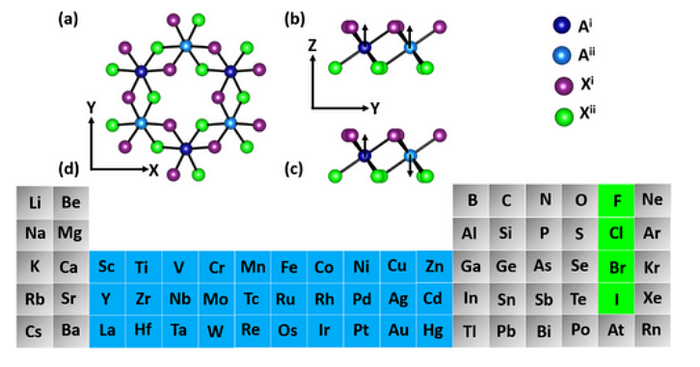
a) The crystal structure of the family of transition metal halides A2X6, based on Cr2I6, used in this study. One or both A sites are replaced with transition metal atoms (highlighted blue in the periodic table in panel (d)) and the X-sites (above and/or below) the plane are replaced with halogens (highlighted green). The magnetic configurations studied are b) ferromagnetic and c) antiferromagnetic. d) The elements used to make chemical substitutions are highlighted in the periodic table.
Rhone and team combined high-throughput density functional theory (DFT) calculations, to determine the vdW materials’ properties, with AI to implement a form of machine learning called semi-supervised learning. Semi-supervised learning uses a combination of labeled and unlabeled data to identify patterns in data and make predictions. Semi-supervised learning mitigates a major challenge in machine learning — the scarcity of labeled data.
“Using AI saves time and money,” said Rhone. “The typical materials discovery process requires expensive simulations on a supercomputer that can take months. Lab experiments can take even longer and can be more expensive. An AI approach has the potential to speed up the materials discovery process.”
Using an initial subset of 700 DFT calculations on a supercomputer, an AI model was trained that could predict the properties of many thousands of materials candidates in milliseconds on a laptop. The team then identified promising candidate vdW materials with large magnetic moments and low formation energy. Low formation energy is an indicator of chemical stability, which is an important requirement for synthesizing the material in a laboratory and subsequent industrial applications.
“Our framework can easily be applied to explore materials with different crystal structures, as well,” said Rhone. “Mixed crystal structure prototypes, such as a data set of both transition metal halides and transition metal trichalcogenides, can also be explored with this framework.”
“Dr. Rhone’s application of AI to the field of materials science continues to produce exciting results,” said Curt Breneman, dean of Rensselaer’s School of Science. “He has not only accelerated our understanding of 2D materials that have novel properties, but his findings and methods are likely to contribute to new quantum computing technologies.”
Subscribe to Paradigm!
Medium. Twitter. Telegram. Telegram Chat. Reddit. LinkedIn.
Main sources
Research articles